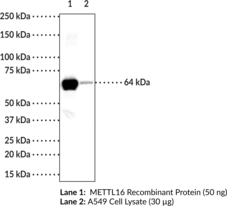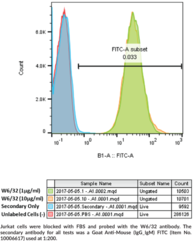Cayman
Showing 29251–29400 of 45550 results
-
Metronidazole-d4 is intended for use as an internal standard for the quantification of metronidazole (Item No. 9002409) by GC- or LC-MS. Metronidazole is an antibiotic that has activity against anaerobic bacteria and protozoa including T. vaginalis, E. histolytica, G. lamblia, C. difficile, and H. pylori.{32541} It reduces the growth of E. coli in vitro (MIC = 128 mg/L under anaerobic conditions).{37625} In vivo, metronidazole reduces viable counts of B. fragilis in a rabbit model of infection. Formulations containing metronidazole have been used in the treatment of various infections including H. pylori and C. difficile.
Brand:CaymanSKU:10010659 - 1 mgAvailable on backorder
Methyltransferase-like protein 16 (METTL16) is an m6A RNA methyltransferase encoded by the METTL16 gene in humans and localized to the cell nucleus.{50141,56098} It is composed of a methyltransferase domain that associates with RNA and two vertebrate conserved regions (VCRs) on the C-terminal end that promote splicing.{49283} METTL16 acts as an epigenetic writer by methylating the pre-mRNA of the S-adenosylmethionine (SAM) synthetase MAT2A in the presence of SAM. It also methylates the adenine at position 43 of spliceosome component U6 snRNA and interacts with cancer-associated MALAT1 long non-coding RNA (lncRNA).{35512,50141} Knockout of Mettl16 in mouse embryos leads to a reduction in Mat2a mRNA expression, transcriptome dysregulation, and lethality at approximately the implantation stage.{49284} The expression of METTL16 is increased in isolated human colon, but not rectal, adenocarcinoma tumor tissue, and decreased METTL16 expression in rectal adenocarcinoma tumor tissue is associated with lower overall survival.{49285} Cayman’s METTL16 Monoclonal Antibody can be used for ELISA, Immunofluorescence, and Western blot applications. The antibody recognizes METTL16 at 64 kDa from human samples.
Brand:CaymanSKU:29207 - 100 µgAvailable on backorder
Immunogen: Full-length recombinant human METTL16 • Host: Mouse • Species Reactivity: (+) Human • Applications: ELISA, IF, and WB • MW: 64 kDa
Brand:CaymanSKU:29207- 100 µgAvailable on backorder
Immunogen: Full-length recombinant human METTL16 • Host: Mouse • Species Reactivity: (+) Human • Applications: ELISA, IF, and WB • MW: 64 kDa
Brand:CaymanSKU:29207- 100 µgImmunogen: Recombinant human METTL3/14 complex • Host: Mouse • Species Reactivity: (+) Human • Applications: ELISA, WB • MW = 64 and 52 kDa for METTL3 and METTL14, respectively
Brand:CaymanSKU:29313- 200 µgMethyltransferase-like protein 3 (METTL3) and METTL14 are m6A RNA methyltransferases encoded by the METTL3 and METTL14 genes, respectively, in humans.{50138} METTL3 and METTL14 form a stable complex in the cytoplasm then localize to the nucleus via a METTL3 nuclear localization sequence. METTL3 contains an N-terminal leader helix domain that interacts with Wilms’ tumor 1-associated protein (WTAP) in the nucleus, which confers localization of the complex to nuclear speckles. METTL14 contains a C-terminal arginine-glycine-glycine (RGG) sequence that contributes to the catalytic activity of the complex. METTL3 and METTL14 each contain methyltransferase domains but the METTL3 domain alone binds S-adenosylmethionine (SAM) or S-adenosylhomocysteine (SAH) while METTL14 interacts with RNA.{45519} The METTL3/14 complex primarily binds to regions of RNA that correspond to intergenic and intron regions of DNA, and it preferentially methylates RNA substrates that contain the sequence GGACU, with little preference for secondary structural features of the substrates.{45520} METTL3 and METTL14 are involved in hematopoietic stem cell differentiation in vitro and are necessary for self-renewal and reconstitution of hematopoietic stem cells following bone marrow transplantation in mice.{45521} Mettl3 knockdown or Mettl14 knockout increases radial glia cell cycle length in embryonic mouse brain, and Mettl14 knockout extends cortical neurogenesis into the postnatal period.{45523} Knockdown of METTL3 or METTL14 also increases proliferation of glioblastoma stem cells (GSCs) in vitro and increases tumor size in a mouse orthotopic model using GSCs.{45524} The expression of METTL3 and METTL14 is reduced in juvenile patients with ETV6/RUNX1(E/R)-positive acute lymphoblastic leukemia (ALL).{45522} Cayman’s METTL3/14 Complex Monoclonal Antibody can be used for ELISA and Western blot (WB) applications. The antibody recognizes METTL3 and METTL14 at approximately 64 and 52 kDa, respectively, from human samples.
Brand:CaymanSKU:29313 - 200 µgAvailable on backorder
Immunogen: Recombinant human METTL3/14 complex • Host: Mouse • Species Reactivity: (+) Human • Applications: ELISA, WB • MW = 64 and 52 kDa for METTL3 and METTL14, respectively
Brand:CaymanSKU:29313- 200 µgAvailable on backorder
Metyrapone blocks cortisol synthesis by inhibiting steroid 11β-hydroxylase in adrenal cortex (IC50 = 7.8 μM).{24101} Metyrapone binds with high affinity to cytochrome P(CYP)450 in hepatic microsomes and induces rat hepatic CYP1A1 and CYP3A gene expression.{24100,24099} It is used to assess adrenal insufficiency, to address hypercortisolism characteristic of Cushing’s syndrome, and may be of clinical value in the treatment of depression and in reducing brain damage resulting from hypoxia-ischemia.{24098,24096,24097}
Brand:CaymanSKU:-Metyrapone blocks cortisol synthesis by inhibiting steroid 11β-hydroxylase in adrenal cortex (IC50 = 7.8 μM).{24101} Metyrapone binds with high affinity to cytochrome P(CYP)450 in hepatic microsomes and induces rat hepatic CYP1A1 and CYP3A gene expression.{24100,24099} It is used to assess adrenal insufficiency, to address hypercortisolism characteristic of Cushing’s syndrome, and may be of clinical value in the treatment of depression and in reducing brain damage resulting from hypoxia-ischemia.{24098,24096,24097}
Brand:CaymanSKU:-Metyrapone blocks cortisol synthesis by inhibiting steroid 11β-hydroxylase in adrenal cortex (IC50 = 7.8 μM).{24101} Metyrapone binds with high affinity to cytochrome P(CYP)450 in hepatic microsomes and induces rat hepatic CYP1A1 and CYP3A gene expression.{24100,24099} It is used to assess adrenal insufficiency, to address hypercortisolism characteristic of Cushing’s syndrome, and may be of clinical value in the treatment of depression and in reducing brain damage resulting from hypoxia-ischemia.{24098,24096,24097}
Brand:CaymanSKU:-Metyrosine is an inhibitor of tyrosine hydroxylase.{35206} In vivo, metyrosine (200 mg/kg) reduces norepinephrine and dopamine levels in rat brain and disrupts conditioned avoidance behavior in a dose-dependent manner. Metyrosine reduces dopamine transporter knockdown-induced hyperactivity and rearing behavior and increases exploratory behavior in a hole board assay in a mouse model of bipolar disorder mania.{35226} It reduces hypertension induced by dexamethasone (Item No. 11015) and cyclosporin in rats.{35214,35212} Metyrosine also inhibits norepinephrine production and increases plasma levels of leptin in fasted and fed mice.{35210}
Brand:CaymanSKU:24001 - 100 mgAvailable on backorder
Metyrosine is an inhibitor of tyrosine hydroxylase.{35206} In vivo, metyrosine (200 mg/kg) reduces norepinephrine and dopamine levels in rat brain and disrupts conditioned avoidance behavior in a dose-dependent manner. Metyrosine reduces dopamine transporter knockdown-induced hyperactivity and rearing behavior and increases exploratory behavior in a hole board assay in a mouse model of bipolar disorder mania.{35226} It reduces hypertension induced by dexamethasone (Item No. 11015) and cyclosporin in rats.{35214,35212} Metyrosine also inhibits norepinephrine production and increases plasma levels of leptin in fasted and fed mice.{35210}
Brand:CaymanSKU:24001 - 250 mgAvailable on backorder
Metyrosine is an inhibitor of tyrosine hydroxylase.{35206} In vivo, metyrosine (200 mg/kg) reduces norepinephrine and dopamine levels in rat brain and disrupts conditioned avoidance behavior in a dose-dependent manner. Metyrosine reduces dopamine transporter knockdown-induced hyperactivity and rearing behavior and increases exploratory behavior in a hole board assay in a mouse model of bipolar disorder mania.{35226} It reduces hypertension induced by dexamethasone (Item No. 11015) and cyclosporin in rats.{35214,35212} Metyrosine also inhibits norepinephrine production and increases plasma levels of leptin in fasted and fed mice.{35210}
Brand:CaymanSKU:24001 - 50 mgAvailable on backorder
Metyrosine is an inhibitor of tyrosine hydroxylase.{35206} In vivo, metyrosine (200 mg/kg) reduces norepinephrine and dopamine levels in rat brain and disrupts conditioned avoidance behavior in a dose-dependent manner. Metyrosine reduces dopamine transporter knockdown-induced hyperactivity and rearing behavior and increases exploratory behavior in a hole board assay in a mouse model of bipolar disorder mania.{35226} It reduces hypertension induced by dexamethasone (Item No. 11015) and cyclosporin in rats.{35214,35212} Metyrosine also inhibits norepinephrine production and increases plasma levels of leptin in fasted and fed mice.{35210}
Brand:CaymanSKU:24001 - 500 mgAvailable on backorder
Mevastatin is a potent, reversible, and competitive HMG-CoA reductase inhibitor with a Ki value of 1 nM for the open ring acid form of the molecule.{15081} In vivo, mevastatin (50 mg/kg) inhibits cholesterogenesis in the liver and ileum of normolipidemic rats, cholestyramine-treated rats, and cholesterol-fed rats.{39406} Mevastatin also suppresses TNF-induced NF-κB activation (IC50 = ~17 µM), which potentiates apoptosis in human myeloid leukemia cells.{15363} Formulations containing mevastatin have been used to reduce plasma LDL-cholesterol in patients with familial hypercholesterolemia.{15081}
Brand:CaymanSKU:10010340 - 10 mgAvailable on backorder
Mevastatin is a potent, reversible, and competitive HMG-CoA reductase inhibitor with a Ki value of 1 nM for the open ring acid form of the molecule.{15081} In vivo, mevastatin (50 mg/kg) inhibits cholesterogenesis in the liver and ileum of normolipidemic rats, cholestyramine-treated rats, and cholesterol-fed rats.{39406} Mevastatin also suppresses TNF-induced NF-κB activation (IC50 = ~17 µM), which potentiates apoptosis in human myeloid leukemia cells.{15363} Formulations containing mevastatin have been used to reduce plasma LDL-cholesterol in patients with familial hypercholesterolemia.{15081}
Brand:CaymanSKU:10010340 - 25 mgAvailable on backorder
Mevastatin is a potent, reversible, and competitive HMG-CoA reductase inhibitor with a Ki value of 1 nM for the open ring acid form of the molecule.{15081} In vivo, mevastatin (50 mg/kg) inhibits cholesterogenesis in the liver and ileum of normolipidemic rats, cholestyramine-treated rats, and cholesterol-fed rats.{39406} Mevastatin also suppresses TNF-induced NF-κB activation (IC50 = ~17 µM), which potentiates apoptosis in human myeloid leukemia cells.{15363} Formulations containing mevastatin have been used to reduce plasma LDL-cholesterol in patients with familial hypercholesterolemia.{15081}
Brand:CaymanSKU:10010340 - 5 mgAvailable on backorder
Mevastatin is a potent, reversible, and competitive HMG-CoA reductase inhibitor with a Ki value of 1 nM for the open ring acid form of the molecule.{15081} In vivo, mevastatin (50 mg/kg) inhibits cholesterogenesis in the liver and ileum of normolipidemic rats, cholestyramine-treated rats, and cholesterol-fed rats.{39406} Mevastatin also suppresses TNF-induced NF-κB activation (IC50 = ~17 µM), which potentiates apoptosis in human myeloid leukemia cells.{15363} Formulations containing mevastatin have been used to reduce plasma LDL-cholesterol in patients with familial hypercholesterolemia.{15081}
Brand:CaymanSKU:10010340 - 50 mgAvailable on backorder
Mezlocillin is a β-lactam antibiotic and derivative of ampicillin (Item No. 14417).{52600,52601} It is active against B. fragilis, E. lentum, P. morbillorum, and F. nucleatum (MICs = 8, 4, 2, and 4 µg/ml, respectively).{52601} Mezlocillin (32 µg/ml) is also active against 10 strains of S. faecalis.{52600} In vivo, mezlocillin (240 mg/kg) increases survival and reduces bacteremia in a rabbit model of S. faecalis endocarditis. It completely eliminates lung P. morbillorum, E. lentum, and F. nucelatum, but not B. fragilis, in a rabbit model of pulmonary P. morbillorum, E. lentum, F. nucelatum, and B. fragilis infection when administered at a dose of 300 mg/kg.{52601} Formulations containing mezlocillin have been used in the treatment of various bacterial infections.
Brand:CaymanSKU:30691 - 1 gAvailable on backorder
Mezlocillin is a β-lactam antibiotic and derivative of ampicillin (Item No. 14417).{52600,52601} It is active against B. fragilis, E. lentum, P. morbillorum, and F. nucleatum (MICs = 8, 4, 2, and 4 µg/ml, respectively).{52601} Mezlocillin (32 µg/ml) is also active against 10 strains of S. faecalis.{52600} In vivo, mezlocillin (240 mg/kg) increases survival and reduces bacteremia in a rabbit model of S. faecalis endocarditis. It completely eliminates lung P. morbillorum, E. lentum, and F. nucelatum, but not B. fragilis, in a rabbit model of pulmonary P. morbillorum, E. lentum, F. nucelatum, and B. fragilis infection when administered at a dose of 300 mg/kg.{52601} Formulations containing mezlocillin have been used in the treatment of various bacterial infections.
Brand:CaymanSKU:30691 - 250 mgAvailable on backorder
Mezlocillin is a β-lactam antibiotic and derivative of ampicillin (Item No. 14417).{52600,52601} It is active against B. fragilis, E. lentum, P. morbillorum, and F. nucleatum (MICs = 8, 4, 2, and 4 µg/ml, respectively).{52601} Mezlocillin (32 µg/ml) is also active against 10 strains of S. faecalis.{52600} In vivo, mezlocillin (240 mg/kg) increases survival and reduces bacteremia in a rabbit model of S. faecalis endocarditis. It completely eliminates lung P. morbillorum, E. lentum, and F. nucelatum, but not B. fragilis, in a rabbit model of pulmonary P. morbillorum, E. lentum, F. nucelatum, and B. fragilis infection when administered at a dose of 300 mg/kg.{52601} Formulations containing mezlocillin have been used in the treatment of various bacterial infections.
Brand:CaymanSKU:30691 - 5 gAvailable on backorder
Mezlocillin is a β-lactam antibiotic and derivative of ampicillin (Item No. 14417).{52600,52601} It is active against B. fragilis, E. lentum, P. morbillorum, and F. nucleatum (MICs = 8, 4, 2, and 4 µg/ml, respectively).{52601} Mezlocillin (32 µg/ml) is also active against 10 strains of S. faecalis.{52600} In vivo, mezlocillin (240 mg/kg) increases survival and reduces bacteremia in a rabbit model of S. faecalis endocarditis. It completely eliminates lung P. morbillorum, E. lentum, and F. nucelatum, but not B. fragilis, in a rabbit model of pulmonary P. morbillorum, E. lentum, F. nucelatum, and B. fragilis infection when administered at a dose of 300 mg/kg.{52601} Formulations containing mezlocillin have been used in the treatment of various bacterial infections.
Brand:CaymanSKU:30691 - 500 mgAvailable on backorder
Prostaglandin E2 (PGE2; Item No. 14010) activates four E prostanoid (EP) receptors, EP1-4. EP4 is a Gs protein-coupled receptor that, by elevating the second messenger cAMP, plays important roles in bone formation and resorption, inflammation, cancer, and atherosclerosis.{16772,16773,16619} MF498 is a selective EP4 receptor antagonist (Ki = 0.7 nM versus a Ki > 1 µM for other EP receptors).{18105} In HEK293 cells expressing the human EP4 receptor, MF498 inhibits EP ligand induced activity with an IC50 value of 1.7 nM.{18105} In various animal models for arthritis, MF498 has been shown to inhibit inflammation without gastrointestinal toxicity (ED50 values as low as 0.02 mg/kg/day).{18105}
Brand:CaymanSKU:-Prostaglandin E2 (PGE2; Item No. 14010) activates four E prostanoid (EP) receptors, EP1-4. EP4 is a Gs protein-coupled receptor that, by elevating the second messenger cAMP, plays important roles in bone formation and resorption, inflammation, cancer, and atherosclerosis.{16772,16773,16619} MF498 is a selective EP4 receptor antagonist (Ki = 0.7 nM versus a Ki > 1 µM for other EP receptors).{18105} In HEK293 cells expressing the human EP4 receptor, MF498 inhibits EP ligand induced activity with an IC50 value of 1.7 nM.{18105} In various animal models for arthritis, MF498 has been shown to inhibit inflammation without gastrointestinal toxicity (ED50 values as low as 0.02 mg/kg/day).{18105}
Brand:CaymanSKU:-Prostaglandin E2 (PGE2; Item No. 14010) activates four E prostanoid (EP) receptors, EP1-4. EP4 is a Gs protein-coupled receptor that, by elevating the second messenger cAMP, plays important roles in bone formation and resorption, inflammation, cancer, and atherosclerosis.{16772,16773,16619} MF498 is a selective EP4 receptor antagonist (Ki = 0.7 nM versus a Ki > 1 µM for other EP receptors).{18105} In HEK293 cells expressing the human EP4 receptor, MF498 inhibits EP ligand induced activity with an IC50 value of 1.7 nM.{18105} In various animal models for arthritis, MF498 has been shown to inhibit inflammation without gastrointestinal toxicity (ED50 values as low as 0.02 mg/kg/day).{18105}
Brand:CaymanSKU:-Prostaglandin E2 (PGE2; Item No. 14010) activates four E prostanoid (EP) receptors, EP1-4. EP4 is a Gs protein-coupled receptor that, by elevating the second messenger cAMP, plays important roles in bone formation and resorption, inflammation, cancer, and atherosclerosis.{16772,16773,16619} MF498 is a selective EP4 receptor antagonist (Ki = 0.7 nM versus a Ki > 1 µM for other EP receptors).{18105} In HEK293 cells expressing the human EP4 receptor, MF498 inhibits EP ligand induced activity with an IC50 value of 1.7 nM.{18105} In various animal models for arthritis, MF498 has been shown to inhibit inflammation without gastrointestinal toxicity (ED50 values as low as 0.02 mg/kg/day).{18105}
Brand:CaymanSKU:-Microsomal prostaglandin E2 synthase-1 (mPGES-1) is the terminal enzyme in the biosynthesis of PGE2.{19887,16438,18830} MF63 is a potent, selective, and orally active inhibitor of human mPGES-1 (IC50 = 1.3 nM).{27593,27594} It displays greater than 1,000-fold selectivity over other prostanoid synthases.{27594} MF63 also potently inhibits guinea pig mPGES-1 (IC50 = 0.9 nM) but not mouse or rat mPGES-1.{27594} In guinea pigs or in mice expressing human mPGES-1, MF63 prevents LPS-induced pyresis, hyperalgesia, and iodoacetate-induced osteoarthritic pain.{27594} It does not produce the gastrointestinal toxicity that is caused by non-selective COX inhibitors, although it markedly suppresses PGE2 synthesis in the stomach.{27594}
Brand:CaymanSKU:-Microsomal prostaglandin E2 synthase-1 (mPGES-1) is the terminal enzyme in the biosynthesis of PGE2.{19887,16438,18830} MF63 is a potent, selective, and orally active inhibitor of human mPGES-1 (IC50 = 1.3 nM).{27593,27594} It displays greater than 1,000-fold selectivity over other prostanoid synthases.{27594} MF63 also potently inhibits guinea pig mPGES-1 (IC50 = 0.9 nM) but not mouse or rat mPGES-1.{27594} In guinea pigs or in mice expressing human mPGES-1, MF63 prevents LPS-induced pyresis, hyperalgesia, and iodoacetate-induced osteoarthritic pain.{27594} It does not produce the gastrointestinal toxicity that is caused by non-selective COX inhibitors, although it markedly suppresses PGE2 synthesis in the stomach.{27594}
Brand:CaymanSKU:-Microsomal prostaglandin E2 synthase-1 (mPGES-1) is the terminal enzyme in the biosynthesis of PGE2.{19887,16438,18830} MF63 is a potent, selective, and orally active inhibitor of human mPGES-1 (IC50 = 1.3 nM).{27593,27594} It displays greater than 1,000-fold selectivity over other prostanoid synthases.{27594} MF63 also potently inhibits guinea pig mPGES-1 (IC50 = 0.9 nM) but not mouse or rat mPGES-1.{27594} In guinea pigs or in mice expressing human mPGES-1, MF63 prevents LPS-induced pyresis, hyperalgesia, and iodoacetate-induced osteoarthritic pain.{27594} It does not produce the gastrointestinal toxicity that is caused by non-selective COX inhibitors, although it markedly suppresses PGE2 synthesis in the stomach.{27594}
Brand:CaymanSKU:-Microsomal prostaglandin E2 synthase-1 (mPGES-1) is the terminal enzyme in the biosynthesis of PGE2.{19887,16438,18830} MF63 is a potent, selective, and orally active inhibitor of human mPGES-1 (IC50 = 1.3 nM).{27593,27594} It displays greater than 1,000-fold selectivity over other prostanoid synthases.{27594} MF63 also potently inhibits guinea pig mPGES-1 (IC50 = 0.9 nM) but not mouse or rat mPGES-1.{27594} In guinea pigs or in mice expressing human mPGES-1, MF63 prevents LPS-induced pyresis, hyperalgesia, and iodoacetate-induced osteoarthritic pain.{27594} It does not produce the gastrointestinal toxicity that is caused by non-selective COX inhibitors, although it markedly suppresses PGE2 synthesis in the stomach.{27594}
Brand:CaymanSKU:-MG149 is a histone acetyltransferase (HAT) inhibitor with IC50 values of 74 and 47 μM, for human recombinant Tip60 and males absent on the first (MOF) HATs, respectively.{41057,41058} MG149 targets the acetyl-CoA binding site and inhibits acetyltransferase activity in the nuclear extract from murine hippocampus, amygdala, and prefrontal cortex.{41059} MG149 also inhibits the p53 and NF-κB pathways.
Brand:CaymanSKU:22135 -Out of stock
MG149 is a histone acetyltransferase (HAT) inhibitor with IC50 values of 74 and 47 μM, for human recombinant Tip60 and males absent on the first (MOF) HATs, respectively.{41057,41058} MG149 targets the acetyl-CoA binding site and inhibits acetyltransferase activity in the nuclear extract from murine hippocampus, amygdala, and prefrontal cortex.{41059} MG149 also inhibits the p53 and NF-κB pathways.
Brand:CaymanSKU:22135 -Out of stock
MG149 is a histone acetyltransferase (HAT) inhibitor with IC50 values of 74 and 47 μM, for human recombinant Tip60 and males absent on the first (MOF) HATs, respectively.{41057,41058} MG149 targets the acetyl-CoA binding site and inhibits acetyltransferase activity in the nuclear extract from murine hippocampus, amygdala, and prefrontal cortex.{41059} MG149 also inhibits the p53 and NF-κB pathways.
Brand:CaymanSKU:22135 -Out of stock
MG149 is a histone acetyltransferase (HAT) inhibitor with IC50 values of 74 and 47 μM, for human recombinant Tip60 and males absent on the first (MOF) HATs, respectively.{41057,41058} MG149 targets the acetyl-CoA binding site and inhibits acetyltransferase activity in the nuclear extract from murine hippocampus, amygdala, and prefrontal cortex.{41059} MG149 also inhibits the p53 and NF-κB pathways.
Brand:CaymanSKU:22135 -Out of stock
MG624 is an antagonist of neuronal nicotinic acetylcholine receptors (nAChRs; Ki = 0.055 µM in neuronal chick optic lobe membranes).{42205} It is selective for neuronal nAChRs over muscle-type AChRs (Ki = 70 µM in TE671 cells that express muscle-type AChRs). MG624 inhibits currents evoked by acetylcholine in Xenopus oocytes expressing chick α7 subunit-containing nAChRs (IC50 = 94 nM). It is selective for α7 subunit-containing nAChRs over α6, β2, and β4 subunit-containing nAChRs (Kis = 4.52, 12, and 9.2 µM, respectively).{42206} It selectively decreases vagus nerve stimulation-induced contractions of isolated guinea pig vagus nerve-stomach preparations (EC50 = 49.4 µM) over isolated rat phrenic nerve-hemidiaphragm preparations (EC50 = 486 µM). MG624 decreases protein levels of early growth response gene 1 (Egr-1) induced by nicotine in human microvascular endothelial cells of the lung (HMEC-Ls).{42207} It also decreases proliferation of HMEC-Ls and inhibits angiogenesis in vitro and ex vivo as well as in an H69 small cell lung cancer (SCLC) mouse xenograft model concomitant with a reduction in tumor growth when administered in the diet at a dose of approximately 10 mg/kg per day.
Brand:CaymanSKU:24298 - 1 mgAvailable on backorder
MG624 is an antagonist of neuronal nicotinic acetylcholine receptors (nAChRs; Ki = 0.055 µM in neuronal chick optic lobe membranes).{42205} It is selective for neuronal nAChRs over muscle-type AChRs (Ki = 70 µM in TE671 cells that express muscle-type AChRs). MG624 inhibits currents evoked by acetylcholine in Xenopus oocytes expressing chick α7 subunit-containing nAChRs (IC50 = 94 nM). It is selective for α7 subunit-containing nAChRs over α6, β2, and β4 subunit-containing nAChRs (Kis = 4.52, 12, and 9.2 µM, respectively).{42206} It selectively decreases vagus nerve stimulation-induced contractions of isolated guinea pig vagus nerve-stomach preparations (EC50 = 49.4 µM) over isolated rat phrenic nerve-hemidiaphragm preparations (EC50 = 486 µM). MG624 decreases protein levels of early growth response gene 1 (Egr-1) induced by nicotine in human microvascular endothelial cells of the lung (HMEC-Ls).{42207} It also decreases proliferation of HMEC-Ls and inhibits angiogenesis in vitro and ex vivo as well as in an H69 small cell lung cancer (SCLC) mouse xenograft model concomitant with a reduction in tumor growth when administered in the diet at a dose of approximately 10 mg/kg per day.
Brand:CaymanSKU:24298 - 10 mgAvailable on backorder
MG624 is an antagonist of neuronal nicotinic acetylcholine receptors (nAChRs; Ki = 0.055 µM in neuronal chick optic lobe membranes).{42205} It is selective for neuronal nAChRs over muscle-type AChRs (Ki = 70 µM in TE671 cells that express muscle-type AChRs). MG624 inhibits currents evoked by acetylcholine in Xenopus oocytes expressing chick α7 subunit-containing nAChRs (IC50 = 94 nM). It is selective for α7 subunit-containing nAChRs over α6, β2, and β4 subunit-containing nAChRs (Kis = 4.52, 12, and 9.2 µM, respectively).{42206} It selectively decreases vagus nerve stimulation-induced contractions of isolated guinea pig vagus nerve-stomach preparations (EC50 = 49.4 µM) over isolated rat phrenic nerve-hemidiaphragm preparations (EC50 = 486 µM). MG624 decreases protein levels of early growth response gene 1 (Egr-1) induced by nicotine in human microvascular endothelial cells of the lung (HMEC-Ls).{42207} It also decreases proliferation of HMEC-Ls and inhibits angiogenesis in vitro and ex vivo as well as in an H69 small cell lung cancer (SCLC) mouse xenograft model concomitant with a reduction in tumor growth when administered in the diet at a dose of approximately 10 mg/kg per day.
Brand:CaymanSKU:24298 - 5 mgAvailable on backorder
MGCD-265 is an orally bioavailable, multi-targeted tyrosine kinase inhibitor, inhibiting MET, VGFR1-3, Tie, and Ron. Formulations containing MGCD-265, alone or in combination with other chemotherapeutic compounds, are being tested in animal models and clinical cancer trials, particularly for non-small cell lung cancer.{29344}
Brand:CaymanSKU:20097 -Available on backorder
MGCD-265 is an orally bioavailable, multi-targeted tyrosine kinase inhibitor, inhibiting MET, VGFR1-3, Tie, and Ron. Formulations containing MGCD-265, alone or in combination with other chemotherapeutic compounds, are being tested in animal models and clinical cancer trials, particularly for non-small cell lung cancer.{29344}
Brand:CaymanSKU:20097 -Available on backorder
MGCD-265 is an orally bioavailable, multi-targeted tyrosine kinase inhibitor, inhibiting MET, VGFR1-3, Tie, and Ron. Formulations containing MGCD-265, alone or in combination with other chemotherapeutic compounds, are being tested in animal models and clinical cancer trials, particularly for non-small cell lung cancer.{29344}
Brand:CaymanSKU:20097 -Available on backorder
MGCD-265 is an orally bioavailable, multi-targeted tyrosine kinase inhibitor, inhibiting MET, VGFR1-3, Tie, and Ron. Formulations containing MGCD-265, alone or in combination with other chemotherapeutic compounds, are being tested in animal models and clinical cancer trials, particularly for non-small cell lung cancer.{29344}
Brand:CaymanSKU:20097 -Available on backorder
MGK-264 is a dicarboxamide synergist used to enhance the effects of pesticides.{43335} It is not lethal to house flies when used at a concentration of 5,000 ppm and induces only 26.4% mortality of two-spotted spider mites when used at a concentration of 1,000 ppm. MGK-264 has synergistic effects on toxicity when used in combination with the insecticide Plictran in susceptible strains of S. littoralis (LD50s = 0.98 and 40 µg/larva with or without MGK-264) and in field strains (LD50s = 0.15 and 1.1 µg/larva with or without MGK-264).{43336} It also decreases the fecundity of adult L. acuminata and reduces survival of the offspring after hatching when used in combination with sublethal doses of a variety of plant-derived molluscicides.{43337}
Brand:CaymanSKU:25819 - 100 mgAvailable on backorder
MGK-264 is a dicarboxamide synergist used to enhance the effects of pesticides.{43335} It is not lethal to house flies when used at a concentration of 5,000 ppm and induces only 26.4% mortality of two-spotted spider mites when used at a concentration of 1,000 ppm. MGK-264 has synergistic effects on toxicity when used in combination with the insecticide Plictran in susceptible strains of S. littoralis (LD50s = 0.98 and 40 µg/larva with or without MGK-264) and in field strains (LD50s = 0.15 and 1.1 µg/larva with or without MGK-264).{43336} It also decreases the fecundity of adult L. acuminata and reduces survival of the offspring after hatching when used in combination with sublethal doses of a variety of plant-derived molluscicides.{43337}
Brand:CaymanSKU:25819 - 50 mgAvailable on backorder
MGL-3196 is an agonist of thyroid hormone receptor β (TRβ; EC50s = 0.21 and 3.74 µM for TRβ and TRα, respectively).{37297} It also inhibits ether-a-go-go-related gene (ERG) potassium channels (IC50 = 30 µM). MGL-3196 is a liver-directed compound, with a liver to plasma ratio of 8:1 in mice with diet-induced obesity (DIO), which reduces the likelihood of adverse effects from systemic exposure. It does not affect the expression of α-myosin heavy chain (α-MHC) in a rat model of hypothyroidism, an effect mediated by TRα, indicating low potential for cardiac adverse effects. MGL-3196 lowers non-HDL cholesterol and liver triglycerides without affecting thyroid stimulating hormone (Tsh) levels in rat and rabbit models of hypercholesterolemia. It also lowers plasma glucose levels and improves insulin sensitivity in DIO mice. Formulations containing MGL-3196 are in clinical trials for the treatment of non-alcoholic steatohepatitis (NASH) and familial hypercholesterolemia.
Brand:CaymanSKU:23845 - 1 mgAvailable on backorder
MGL-3196 is an agonist of thyroid hormone receptor β (TRβ; EC50s = 0.21 and 3.74 µM for TRβ and TRα, respectively).{37297} It also inhibits ether-a-go-go-related gene (ERG) potassium channels (IC50 = 30 µM). MGL-3196 is a liver-directed compound, with a liver to plasma ratio of 8:1 in mice with diet-induced obesity (DIO), which reduces the likelihood of adverse effects from systemic exposure. It does not affect the expression of α-myosin heavy chain (α-MHC) in a rat model of hypothyroidism, an effect mediated by TRα, indicating low potential for cardiac adverse effects. MGL-3196 lowers non-HDL cholesterol and liver triglycerides without affecting thyroid stimulating hormone (Tsh) levels in rat and rabbit models of hypercholesterolemia. It also lowers plasma glucose levels and improves insulin sensitivity in DIO mice. Formulations containing MGL-3196 are in clinical trials for the treatment of non-alcoholic steatohepatitis (NASH) and familial hypercholesterolemia.
Brand:CaymanSKU:23845 - 10 mgAvailable on backorder
MGL-3196 is an agonist of thyroid hormone receptor β (TRβ; EC50s = 0.21 and 3.74 µM for TRβ and TRα, respectively).{37297} It also inhibits ether-a-go-go-related gene (ERG) potassium channels (IC50 = 30 µM). MGL-3196 is a liver-directed compound, with a liver to plasma ratio of 8:1 in mice with diet-induced obesity (DIO), which reduces the likelihood of adverse effects from systemic exposure. It does not affect the expression of α-myosin heavy chain (α-MHC) in a rat model of hypothyroidism, an effect mediated by TRα, indicating low potential for cardiac adverse effects. MGL-3196 lowers non-HDL cholesterol and liver triglycerides without affecting thyroid stimulating hormone (Tsh) levels in rat and rabbit models of hypercholesterolemia. It also lowers plasma glucose levels and improves insulin sensitivity in DIO mice. Formulations containing MGL-3196 are in clinical trials for the treatment of non-alcoholic steatohepatitis (NASH) and familial hypercholesterolemia.
Brand:CaymanSKU:23845 - 5 mgAvailable on backorder
MGR1 is a probe that generates reactive oxygen species (ROS).{35560} Upon activation by esterases, MGR1 produces superoxide in vitro, an effect that is reversed by superoxide dismutase (SOD). MGR1 produces ROS and increases production of oxidized phosphatidylserine species in HEK293T cells. It reduces viability of HEK293T cells (IC50s = 5.1-6.3 μM).
Brand:CaymanSKU:27499 - 1 mgAvailable on backorder
MGR1 is a probe that generates reactive oxygen species (ROS).{35560} Upon activation by esterases, MGR1 produces superoxide in vitro, an effect that is reversed by superoxide dismutase (SOD). MGR1 produces ROS and increases production of oxidized phosphatidylserine species in HEK293T cells. It reduces viability of HEK293T cells (IC50s = 5.1-6.3 μM).
Brand:CaymanSKU:27499 - 500 µgAvailable on backorder
MGR2 is a negative control compound for the activity of the reactive oxygen species-generating probe MGR1 (Item No. 27499).{35560} Unlike MGR1, MGR2 does not induce superoxide production or cell death in HEK293T cells.
Brand:CaymanSKU:27575 - 10 mgAvailable on backorder
MGR2 is a negative control compound for the activity of the reactive oxygen species-generating probe MGR1 (Item No. 27499).{35560} Unlike MGR1, MGR2 does not induce superoxide production or cell death in HEK293T cells.
Brand:CaymanSKU:27575 - 25 mgAvailable on backorder
MGR2 is a negative control compound for the activity of the reactive oxygen species-generating probe MGR1 (Item No. 27499).{35560} Unlike MGR1, MGR2 does not induce superoxide production or cell death in HEK293T cells.
Brand:CaymanSKU:27575 - 5 mgAvailable on backorder
MHAPC-Chol is a cationic cholesterol.{45145} MHAPC-Chol, as part of a lipoplex with DOPE (Item No. 15091), has been used for siRNA delivery and gene silencing in MCF-7 cells in a luciferase assay without affecting cell viability. It has also been used to deliver siRNA into mice via intravenous injection, resulting in MHAPC-chol accumulation in the liver.
Brand:CaymanSKU:26585 - 1 mgAvailable on backorder
MHAPC-Chol is a cationic cholesterol.{45145} MHAPC-Chol, as part of a lipoplex with DOPE (Item No. 15091), has been used for siRNA delivery and gene silencing in MCF-7 cells in a luciferase assay without affecting cell viability. It has also been used to deliver siRNA into mice via intravenous injection, resulting in MHAPC-chol accumulation in the liver.
Brand:CaymanSKU:26585 - 10 mgAvailable on backorder
MHAPC-Chol is a cationic cholesterol.{45145} MHAPC-Chol, as part of a lipoplex with DOPE (Item No. 15091), has been used for siRNA delivery and gene silencing in MCF-7 cells in a luciferase assay without affecting cell viability. It has also been used to deliver siRNA into mice via intravenous injection, resulting in MHAPC-chol accumulation in the liver.
Brand:CaymanSKU:26585 - 5 mgAvailable on backorder
MHAPC-Chol is a cationic cholesterol.{45145} MHAPC-Chol, as part of a lipoplex with DOPE (Item No. 15091), has been used for siRNA delivery and gene silencing in MCF-7 cells in a luciferase assay without affecting cell viability. It has also been used to deliver siRNA into mice via intravenous injection, resulting in MHAPC-chol accumulation in the liver.
Brand:CaymanSKU:26585 - 500 µgAvailable on backorder
Immunogen: Cell membranes of human tonsil lymphocytes • Clone designation: W6/32 • Host: Mouse • Species Reactivity: (+) Human, baboon, bovine, monkey, MHC Class I • Isotype: IgG2 • Applications: FC and IP
Brand:CaymanSKU:20898- 100 µgAvailable on backorder
Immunogen: Cell membranes of human tonsil lymphocytes • Clone designation: W6/32 • Host: Mouse • Species Reactivity: (+) Human, baboon, bovine, monkey, MHC Class I • Isotype: IgG2 • Applications: FC and IP
Brand:CaymanSKU:20898- 100 µgMajor histocompatibility complex (MHC) molecules, also designated human leukocyte antigen (HLA) molecules, are cell-surface receptors that bind foreign peptides and present them to T lymphocytes.{33427} MHC class I molecules consist of two polypeptide chains, an α or heavy chain, and β2-microglobulin, a non-covalently associated protein.{28687} Cytotoxic T lymphocytes bind antigenic peptides presented by MHC class I molecules.{33425} Antigens that bind to MHC class I molecules are typically 8-10 residues in length and are stabilized in a peptide binding groove.{33426} HLA-class I MHC antigens are intrinsic membrane glycoproteins expressed on nucleated cells and non-covalently associated with an invariant β2-microglobulin. They carry foreign determinants important for immune recognition by cytotoxic T cells and are thus important for antiviral and antitumor defense. {33425} Human HLA-class I antigens are represented by HLA-A, HLA-B, and HLA-C molecules
Brand:CaymanSKU:20898 - 100 µgAvailable on backorder
MHY1485 is a cell-permeable activator of mTOR that has been shown to increase levels of cellular mTOR Ser2448 and downstream substrate 4E-BP Thr37/46 phosphorylation in rat liver Ac2F cells.{32639} It can induce cellular LC3-II accumulation in Ac2F cells and has been shown to inhibit autophagy by suppressing the fusion between autophagosomes and lysosomes.{32639}
Brand:CaymanSKU:-Available on backorder
MHY1485 is a cell-permeable activator of mTOR that has been shown to increase levels of cellular mTOR Ser2448 and downstream substrate 4E-BP Thr37/46 phosphorylation in rat liver Ac2F cells.{32639} It can induce cellular LC3-II accumulation in Ac2F cells and has been shown to inhibit autophagy by suppressing the fusion between autophagosomes and lysosomes.{32639}
Brand:CaymanSKU:-Available on backorder
MHY1485 is a cell-permeable activator of mTOR that has been shown to increase levels of cellular mTOR Ser2448 and downstream substrate 4E-BP Thr37/46 phosphorylation in rat liver Ac2F cells.{32639} It can induce cellular LC3-II accumulation in Ac2F cells and has been shown to inhibit autophagy by suppressing the fusion between autophagosomes and lysosomes.{32639}
Brand:CaymanSKU:-Available on backorder
MHY1485 is a cell-permeable activator of mTOR that has been shown to increase levels of cellular mTOR Ser2448 and downstream substrate 4E-BP Thr37/46 phosphorylation in rat liver Ac2F cells.{32639} It can induce cellular LC3-II accumulation in Ac2F cells and has been shown to inhibit autophagy by suppressing the fusion between autophagosomes and lysosomes.{32639}
Brand:CaymanSKU:-Available on backorder
MHY908 is a dual agonist of peroxisome proliferator-activated receptor α (PPARα) and PPARγ that increases transcriptional activity of PPARα and PPARγ in a luciferase reporter assay in AC2F rat liver cells when used at a concentration of 5 µM.{29289} In vivo, MHY908 (3 mg/kg per day) reduces serum glucose, triglyceride, and insulin levels and improves hepatic steatosis by reducing hepatic triglyceride levels and lipid droplet accumulation in db/db mice and 20-month-old rats.{29289,37693} It reduces peroxynitrite and COX-2 levels, reactive oxygen species (ROS) production, and Akt phosphorylation in isolated kidney from 20-month-old rats when administered at a dose of 3 mg/kg.{37693} MHY908 inhibits mushroom tyrosinase (IC50 = 8.19 µM).{37692} It also inhibits increases in melanin content in α-melanocyte stimulating hormone-induced B16/F10 murine melanoma cells when used at a concentration of 10 µM.
Brand:CaymanSKU:-Available on backorder
MHY908 is a dual agonist of peroxisome proliferator-activated receptor α (PPARα) and PPARγ that increases transcriptional activity of PPARα and PPARγ in a luciferase reporter assay in AC2F rat liver cells when used at a concentration of 5 µM.{29289} In vivo, MHY908 (3 mg/kg per day) reduces serum glucose, triglyceride, and insulin levels and improves hepatic steatosis by reducing hepatic triglyceride levels and lipid droplet accumulation in db/db mice and 20-month-old rats.{29289,37693} It reduces peroxynitrite and COX-2 levels, reactive oxygen species (ROS) production, and Akt phosphorylation in isolated kidney from 20-month-old rats when administered at a dose of 3 mg/kg.{37693} MHY908 inhibits mushroom tyrosinase (IC50 = 8.19 µM).{37692} It also inhibits increases in melanin content in α-melanocyte stimulating hormone-induced B16/F10 murine melanoma cells when used at a concentration of 10 µM.
Brand:CaymanSKU:-Available on backorder
MHY908 is a dual agonist of peroxisome proliferator-activated receptor α (PPARα) and PPARγ that increases transcriptional activity of PPARα and PPARγ in a luciferase reporter assay in AC2F rat liver cells when used at a concentration of 5 µM.{29289} In vivo, MHY908 (3 mg/kg per day) reduces serum glucose, triglyceride, and insulin levels and improves hepatic steatosis by reducing hepatic triglyceride levels and lipid droplet accumulation in db/db mice and 20-month-old rats.{29289,37693} It reduces peroxynitrite and COX-2 levels, reactive oxygen species (ROS) production, and Akt phosphorylation in isolated kidney from 20-month-old rats when administered at a dose of 3 mg/kg.{37693} MHY908 inhibits mushroom tyrosinase (IC50 = 8.19 µM).{37692} It also inhibits increases in melanin content in α-melanocyte stimulating hormone-induced B16/F10 murine melanoma cells when used at a concentration of 10 µM.
Brand:CaymanSKU:-Available on backorder
MHY908 is a dual agonist of peroxisome proliferator-activated receptor α (PPARα) and PPARγ that increases transcriptional activity of PPARα and PPARγ in a luciferase reporter assay in AC2F rat liver cells when used at a concentration of 5 µM.{29289} In vivo, MHY908 (3 mg/kg per day) reduces serum glucose, triglyceride, and insulin levels and improves hepatic steatosis by reducing hepatic triglyceride levels and lipid droplet accumulation in db/db mice and 20-month-old rats.{29289,37693} It reduces peroxynitrite and COX-2 levels, reactive oxygen species (ROS) production, and Akt phosphorylation in isolated kidney from 20-month-old rats when administered at a dose of 3 mg/kg.{37693} MHY908 inhibits mushroom tyrosinase (IC50 = 8.19 µM).{37692} It also inhibits increases in melanin content in α-melanocyte stimulating hormone-induced B16/F10 murine melanoma cells when used at a concentration of 10 µM.
Brand:CaymanSKU:-Available on backorder
MI 2 is an inhibitor of the paracaspase MALT1 with an IC50 value of 5.84 μM in a fluorescence assay.{36194} It inhibits the growth of MALT1-dependent activated B cell-like diffuse large B cell lymphoma (ABC-DLBCL) cell lines (GI50s = 0.2, 0.5, 0.4, and 0.4 μM for HBL-1, TMD8, OCI-Ly3, and OCI-Ly10 cells, respectively). MI 2 inhibits cleavage of the MALT1 target protein CYLD in a dose-dependent manner in HBL-1 cells but does not inhibit caspase-3, caspase-8, and caspase-9, which are structurally similar to MALT1. MI 2 (25 mg/kg, i.v.) reduces tumor size in TMD8 and HBL-1 mouse xenograft models.
Brand:CaymanSKU:23437 - 1 mgAvailable on backorder
MI 2 is an inhibitor of the paracaspase MALT1 with an IC50 value of 5.84 μM in a fluorescence assay.{36194} It inhibits the growth of MALT1-dependent activated B cell-like diffuse large B cell lymphoma (ABC-DLBCL) cell lines (GI50s = 0.2, 0.5, 0.4, and 0.4 μM for HBL-1, TMD8, OCI-Ly3, and OCI-Ly10 cells, respectively). MI 2 inhibits cleavage of the MALT1 target protein CYLD in a dose-dependent manner in HBL-1 cells but does not inhibit caspase-3, caspase-8, and caspase-9, which are structurally similar to MALT1. MI 2 (25 mg/kg, i.v.) reduces tumor size in TMD8 and HBL-1 mouse xenograft models.
Brand:CaymanSKU:23437 - 10 mgAvailable on backorder
MI 2 is an inhibitor of the paracaspase MALT1 with an IC50 value of 5.84 μM in a fluorescence assay.{36194} It inhibits the growth of MALT1-dependent activated B cell-like diffuse large B cell lymphoma (ABC-DLBCL) cell lines (GI50s = 0.2, 0.5, 0.4, and 0.4 μM for HBL-1, TMD8, OCI-Ly3, and OCI-Ly10 cells, respectively). MI 2 inhibits cleavage of the MALT1 target protein CYLD in a dose-dependent manner in HBL-1 cells but does not inhibit caspase-3, caspase-8, and caspase-9, which are structurally similar to MALT1. MI 2 (25 mg/kg, i.v.) reduces tumor size in TMD8 and HBL-1 mouse xenograft models.
Brand:CaymanSKU:23437 - 25 mgAvailable on backorder
MI 2 is an inhibitor of the paracaspase MALT1 with an IC50 value of 5.84 μM in a fluorescence assay.{36194} It inhibits the growth of MALT1-dependent activated B cell-like diffuse large B cell lymphoma (ABC-DLBCL) cell lines (GI50s = 0.2, 0.5, 0.4, and 0.4 μM for HBL-1, TMD8, OCI-Ly3, and OCI-Ly10 cells, respectively). MI 2 inhibits cleavage of the MALT1 target protein CYLD in a dose-dependent manner in HBL-1 cells but does not inhibit caspase-3, caspase-8, and caspase-9, which are structurally similar to MALT1. MI 2 (25 mg/kg, i.v.) reduces tumor size in TMD8 and HBL-1 mouse xenograft models.
Brand:CaymanSKU:23437 - 5 mgAvailable on backorder
MI-136 is an inhibitor of the menin-MLL interaction (IC50 = 31 nM; Kd = 23.6 nM).{30618,28761} By blocking MLL recruitment predominantly at the level of the menin-MLL interaction, it can inhibit androgen receptor (AR)-mediated transcription.{32723} At 40 mg/kg, MI-136 has been shown to block AR signaling, inhibiting the growth of castration-resistant tumors in mice.{32723}
Brand:CaymanSKU:-Available on backorder
MI-136 is an inhibitor of the menin-MLL interaction (IC50 = 31 nM; Kd = 23.6 nM).{30618,28761} By blocking MLL recruitment predominantly at the level of the menin-MLL interaction, it can inhibit androgen receptor (AR)-mediated transcription.{32723} At 40 mg/kg, MI-136 has been shown to block AR signaling, inhibiting the growth of castration-resistant tumors in mice.{32723}
Brand:CaymanSKU:-Available on backorder
MI-136 is an inhibitor of the menin-MLL interaction (IC50 = 31 nM; Kd = 23.6 nM).{30618,28761} By blocking MLL recruitment predominantly at the level of the menin-MLL interaction, it can inhibit androgen receptor (AR)-mediated transcription.{32723} At 40 mg/kg, MI-136 has been shown to block AR signaling, inhibiting the growth of castration-resistant tumors in mice.{32723}
Brand:CaymanSKU:-Available on backorder
MI-136 is an inhibitor of the menin-MLL interaction (IC50 = 31 nM; Kd = 23.6 nM).{30618,28761} By blocking MLL recruitment predominantly at the level of the menin-MLL interaction, it can inhibit androgen receptor (AR)-mediated transcription.{32723} At 40 mg/kg, MI-136 has been shown to block AR signaling, inhibiting the growth of castration-resistant tumors in mice.{32723}
Brand:CaymanSKU:-Available on backorder
MI-192 is an inhibitor of histone deacetylases (HDACs) that preferentially inhibits HDAC2 (IC50 = 30 nM) and HDAC3 (IC50 = 16 nM) over HDAC1, 4, 6, 7, and 8 (IC50s = 4.8, 5, >10, 4.1, and >10 μM, respectively).{29271} At 0.1-0.4 μM, it induces differentiation and promotes apoptosis of acute myeloid leukemic cell lines U937, HL60, and Kasumi-1.{29271}
Brand:CaymanSKU:-Available on backorder
MI-192 is an inhibitor of histone deacetylases (HDACs) that preferentially inhibits HDAC2 (IC50 = 30 nM) and HDAC3 (IC50 = 16 nM) over HDAC1, 4, 6, 7, and 8 (IC50s = 4.8, 5, >10, 4.1, and >10 μM, respectively).{29271} At 0.1-0.4 μM, it induces differentiation and promotes apoptosis of acute myeloid leukemic cell lines U937, HL60, and Kasumi-1.{29271}
Brand:CaymanSKU:-Available on backorder
MI-192 is an inhibitor of histone deacetylases (HDACs) that preferentially inhibits HDAC2 (IC50 = 30 nM) and HDAC3 (IC50 = 16 nM) over HDAC1, 4, 6, 7, and 8 (IC50s = 4.8, 5, >10, 4.1, and >10 μM, respectively).{29271} At 0.1-0.4 μM, it induces differentiation and promotes apoptosis of acute myeloid leukemic cell lines U937, HL60, and Kasumi-1.{29271}
Brand:CaymanSKU:-Available on backorder
MI-2 is an inhibitor of the protein-protein interaction between menin and mixed lineage leukemia (MLL) fusion proteins (IC50 = 446 nM).{20716} It binds to menin (Kd = 158 nM) and inhibits the menin interaction with the MLL fusion protein MLL-AF9 in HEK293 cells without affecting protein levels of menin or MLL-AF9. MI-2 inhibits the growth of mouse bone marrow cells (BMCs) expressing the Hoxa9 transformation-dependent MLL-AF9 (GI50 = 5 μM). It also inhibits the growth of MV4, KOPN-8, ML-2, and MonoMac6 MLL cells expressing MLL fusion proteins (GI50s = 9.5, 7.2, 8.7, and 18 μM, respectively), as well as induces hematopoietic differentiation.
Brand:CaymanSKU:29218 - 10 mgAvailable on backorder
MI-2 is an inhibitor of the protein-protein interaction between menin and mixed lineage leukemia (MLL) fusion proteins (IC50 = 446 nM).{20716} It binds to menin (Kd = 158 nM) and inhibits the menin interaction with the MLL fusion protein MLL-AF9 in HEK293 cells without affecting protein levels of menin or MLL-AF9. MI-2 inhibits the growth of mouse bone marrow cells (BMCs) expressing the Hoxa9 transformation-dependent MLL-AF9 (GI50 = 5 μM). It also inhibits the growth of MV4, KOPN-8, ML-2, and MonoMac6 MLL cells expressing MLL fusion proteins (GI50s = 9.5, 7.2, 8.7, and 18 μM, respectively), as well as induces hematopoietic differentiation.
Brand:CaymanSKU:29218 - 25 mgAvailable on backorder
MI-2 is an inhibitor of the protein-protein interaction between menin and mixed lineage leukemia (MLL) fusion proteins (IC50 = 446 nM).{20716} It binds to menin (Kd = 158 nM) and inhibits the menin interaction with the MLL fusion protein MLL-AF9 in HEK293 cells without affecting protein levels of menin or MLL-AF9. MI-2 inhibits the growth of mouse bone marrow cells (BMCs) expressing the Hoxa9 transformation-dependent MLL-AF9 (GI50 = 5 μM). It also inhibits the growth of MV4, KOPN-8, ML-2, and MonoMac6 MLL cells expressing MLL fusion proteins (GI50s = 9.5, 7.2, 8.7, and 18 μM, respectively), as well as induces hematopoietic differentiation.
Brand:CaymanSKU:29218 - 5 mgAvailable on backorder
MI-2 is an inhibitor of the protein-protein interaction between menin and mixed lineage leukemia (MLL) fusion proteins (IC50 = 446 nM).{20716} It binds to menin (Kd = 158 nM) and inhibits the menin interaction with the MLL fusion protein MLL-AF9 in HEK293 cells without affecting protein levels of menin or MLL-AF9. MI-2 inhibits the growth of mouse bone marrow cells (BMCs) expressing the Hoxa9 transformation-dependent MLL-AF9 (GI50 = 5 μM). It also inhibits the growth of MV4, KOPN-8, ML-2, and MonoMac6 MLL cells expressing MLL fusion proteins (GI50s = 9.5, 7.2, 8.7, and 18 μM, respectively), as well as induces hematopoietic differentiation.
Brand:CaymanSKU:29218 - 50 mgAvailable on backorder























